Earning our stripes
“We’ll do what we can, but you know we can’t guarantee them”. This was a familiar refrain from our naturalists when we said we wanted to see tigers. To give ourselves the best chance, we chose three national parks in India’s ‘Tiger State’, Madhya Pradesh: Kanha (where we stayed at Kipling Camp), Bandhavgarh (Samode Safari Lodge) and Panna (Sarai at Toria). These three, were also close enough to travel between by road, journeys of around 4 hours.
We found Indian safari quite different to African ones we’d experienced.
Lodges are not permitted in the parks and the villagers who inhabited them were cleared some time ago, as it was thought they were contributing to the decline of the tiger population. Lodge locations necessitated a drive of up to 40 minutes to the park entrance which meant setting off earlier than normal and very cold mornings travelling in open jeeps on open roads. Although we’d taken hats and gloves, our lodges provided warm ponchos or coats, blankets to wrap around us and hot water bottles. One afternoon, the heavens opened but the jeep had a stash of raincoats, hats and waterproof ponchos but unfortunately, no roof!
Only 20% of the parks, which are sub-divided into zones, are open to visitors and vehicle numbers are restricted. Advance bookings are required with queues forming at the entrances whilst paperwork and the mandatory passport checks are performed. Despite having a driver/naturalist, guides were mandatory, allocated at random on arrival and according to our lodge naturalists, of variable quality.
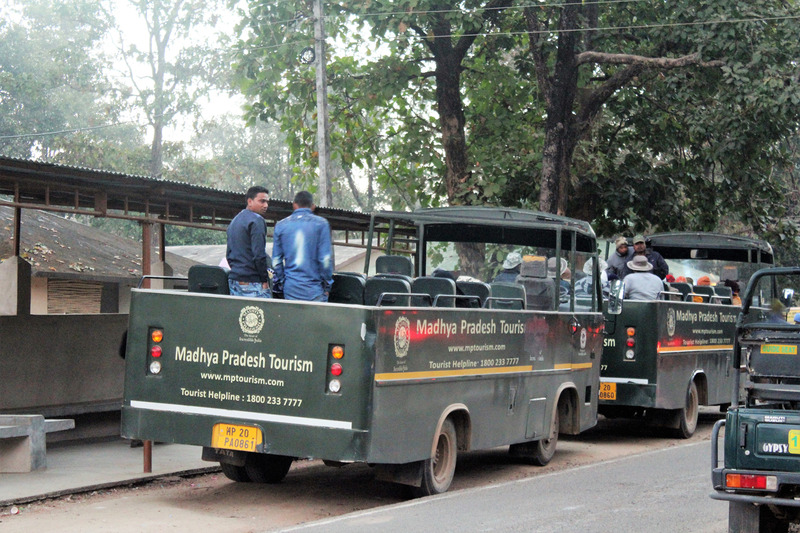 Once in the park, the open jeeps must stick to the tracks and there’s no off-roading. The terrain wasn’t always conducive to game viewing with lots of dense bamboo, heavy forest, thick vegetation and a lack of wide open spaces. Radio communications are forbidden to avoid sightings being swamped by vehicles, so instead of listening to crackling radios, we listened for animal ‘alarm calls’.
Once in the park, the open jeeps must stick to the tracks and there’s no off-roading. The terrain wasn’t always conducive to game viewing with lots of dense bamboo, heavy forest, thick vegetation and a lack of wide open spaces. Radio communications are forbidden to avoid sightings being swamped by vehicles, so instead of listening to crackling radios, we listened for animal ‘alarm calls’.
The parks had large, open, single decker tourist safari buses accommodating around 40 people, ideal for those on a budget – local families and student groups – but not wildlife friendly. We felt our hopes of tiger sightings slipping away.
During our travels, we found that the concept of taking rubbish away with you, wasn’t recognised and because of this, picnic breakfasts had to be eaten in designated areas to avoid littering which was a great shame. It was worse in Kanha, where instead of standing in the warming sun, we were herded into a grim, cold dark building. Still here at least the loos were good: Roy visited the gents in Bandhavgarh and returned saying “hold on if you can, they’re grim”. I took his advice.
 Whilst our Bandhavgarh guide was laying out a sumptuous buffet on the jeep tailgate, a young guy from the tourist bus began to take what he thought were sneaky selfies with our breakfast in the background. His girlfriend then took photographs of him standing in front of the jeep, before he plucked up courage and asked to sit in the driver’s seat. We reciprocated by having our photograph taken in front of the tourist bus.
Whilst our Bandhavgarh guide was laying out a sumptuous buffet on the jeep tailgate, a young guy from the tourist bus began to take what he thought were sneaky selfies with our breakfast in the background. His girlfriend then took photographs of him standing in front of the jeep, before he plucked up courage and asked to sit in the driver’s seat. We reciprocated by having our photograph taken in front of the tourist bus.
Bandhavgarh, with India’s highest concentration of tigers, failed to deliver tigers despite four game drives. At the end of our final drive in Kanha, we’d still not spotted tiger and had packed away binoculars and camera as we were leaving the park on a stretch of tarmac road. We then came across parked jeeps, stopped, whipped out our equipment and after about 10 minutes spotted a tiger. Hooray! Our naturalist grabbed my camera and snapped away so I could concentrate on watching the magnificent beast.
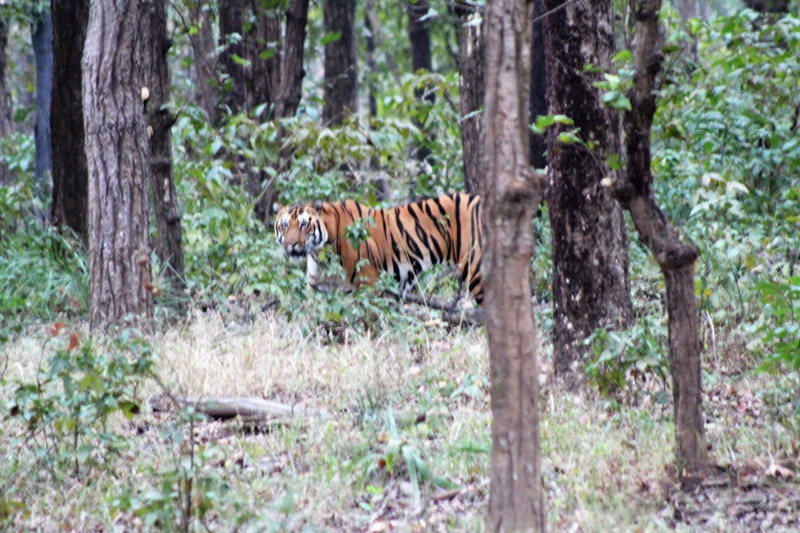 Our second sighting was in the early morning at Panna, where 11 of the 40 tigers are tracked via collars. We’d driven along a dry river bed and were just about to leave, when our guide spotted a female tiger in the bushes on the opposite bank about 8 meters away. We could now rest easy, and our naturalists breathed sighs of relief!
Our second sighting was in the early morning at Panna, where 11 of the 40 tigers are tracked via collars. We’d driven along a dry river bed and were just about to leave, when our guide spotted a female tiger in the bushes on the opposite bank about 8 meters away. We could now rest easy, and our naturalists breathed sighs of relief!
We also saw jackal, wild boar, the four types of deer (barasingha, chital, muntjac and sambar) and both langur and rhesus macaque monkeys. The bird population was more varied and we spotted wonderfully named birds like drongo and rufus tree pike and the wonderfully coloured, Indian roller. However, we were surprised that the variety of game was very low compared to Africa but, if you want tigers it’s the place to be.
We were lucky, we spotted two tigers during our stay, but fellow guests weren’t. My only tip would be to spend as much time as possible in the parks but manage your expectations. It’s also worth bearing in mind when planning itineraries, that it’s ‘half-day closing’ in the parks on Wednesdays.
Kipling Camp
We spent two nights at the fifteen-roomed, Kipling Camp, near Kanha National Park, in the Tiger State of Madya Pradesh. The camp is owned by Belinda Wright OBE and was established in 1982, one of the first wildlife camps in India.
Our semi-detached, white-washed lodge had a shared balcony with plenty of chairs and a table whilst a double hammock swung invitingly nearby.
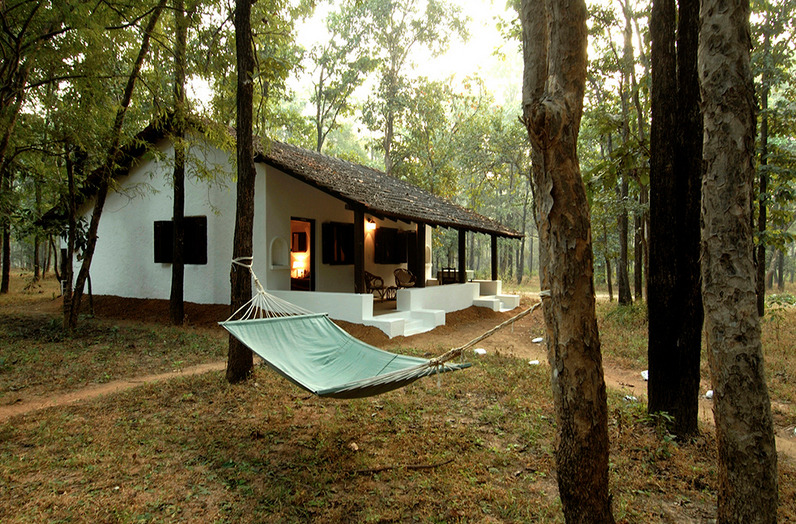 The reasonably-sized room had a four-poster bed with mosquito net, although we were told there wasn’t a huge problem in January. It was well equipped with fluffy maroon dressing gowns, white towelling slippers, two long shelves for storage, a torch and a whistle to blow if we felt under attack! Nights were chilly and we were grateful for the hot water bottles we found in our beds. A safe was provided in the office and although WiFi was available here, it was intermittent.
The reasonably-sized room had a four-poster bed with mosquito net, although we were told there wasn’t a huge problem in January. It was well equipped with fluffy maroon dressing gowns, white towelling slippers, two long shelves for storage, a torch and a whistle to blow if we felt under attack! Nights were chilly and we were grateful for the hot water bottles we found in our beds. A safe was provided in the office and although WiFi was available here, it was intermittent.
The bathroom was a good size with a large open shower and plenty of hot water. Again, there were two huge shelves for toiletries and a clothes dryer for towels. Whilst there was an effective and welcome electric heater, it lacked a hairdryer.
The communal eating area had a well-stocked library and a bar. Food preferences and allergies were catered for, with Indian meals served at lunch and continental at dinner. Water was put through a high-tech filtration system and we were asked to take any plastic bottles away with us.
Wake up calls for the game drives were at 5.15am with tea and biscuits being left on the veranda. Picnic breakfasts were in the park and we feasted on juices, fruit and excellent chapatti wraps of what was described as ‘egg mayonnaise mixed with onion bhaji’ – odd sounding but delicious.
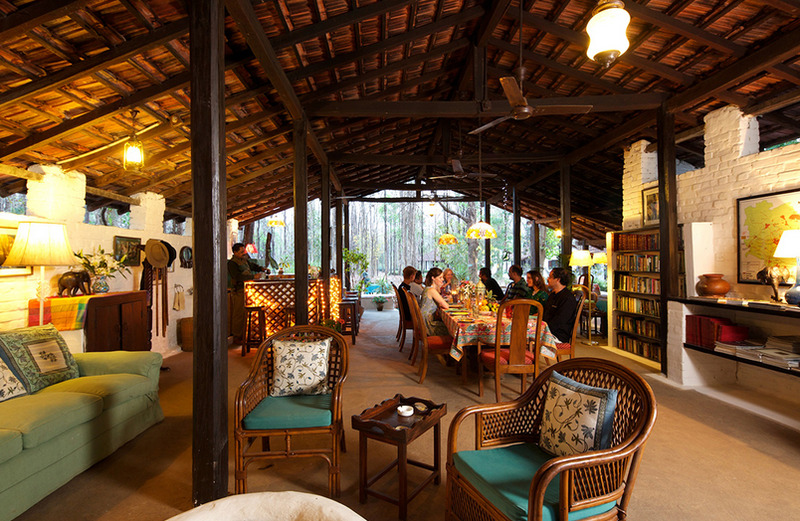 Our first lunch, eaten al fresco at the lodge was chicken curry, rice, potato, green beans and salad all served on a large round silver tray with lentil dal and yoghurt and poppadoms and paratha on the table. A true feast and siesta inducing.
Our first lunch, eaten al fresco at the lodge was chicken curry, rice, potato, green beans and salad all served on a large round silver tray with lentil dal and yoghurt and poppadoms and paratha on the table. A true feast and siesta inducing.
We gathered around the brick circle fireplace at 7pm and enjoyed pre-dinner G&Ts whilst breakfast orders were taken and nibbles (e.g. strips of cheese on toast or pakora) and soup in mugs, was served. A buffet dinner one night was fried chicken, potato wedges and vegetables followed by flambeed bananas in rum sauce.
Kipling Camp is the home of Asia’s most famous elephant, Tara, the heroine of Mark Shand’s epic tale ‘Travels on my Elephant’. The two mahouts, Lavkush and Diva, take Tara for a daily bath. We followed her on the 20-minute walk down to the river and although we were originally close behind, it was amazing how quickly she walked for someone of her size. Eventually we heard a huge splash and saw ripples: she’d not waited. After luxuriating in the water, Tara was led to a shallow section of river where we had fun scrubbing her with stones. She was enticed out of the water with freshly plucked greens when she used the twigs to scratch between her toes as this is where elephants are prone to infection.
We were the only guests during our stay and really got to know all the staff and their enthusiasm and stories really added to our enjoyment.
On a final note, credit cards are not taken.
Samode
We’ve stayed at some luxurious African camps, but Samode Safari Lodge, near India’s Bandhavgarh National Park, beat them all. Our room, one of 12, was more of an apartment and, as I’m not going to repeatedly write ‘large’ in front of everything I describe, just think BIG.
Our courtyard led us into a sitting room with four seater sofa, arm chair, footstool with laid out chess table, flat screen TV, tea making facilities, fancy coffee machine and mini bar with soft drinks. Decor was ornate: a glass chandelier, object d’art and beautiful black and white portraits adorning the walls. In case we were bored, there was a yoga mat, coloured pencils and sketch pad and a list of 100+ DVDs which could be borrowed.
Off this room was a loo and hand basin.
The bedroom, with dark wooden floor and rugs, had orange toned cushions, embroidered wall art above the bed and a chaise-longue, desk, chair, mirror and antique, circular occasional table.
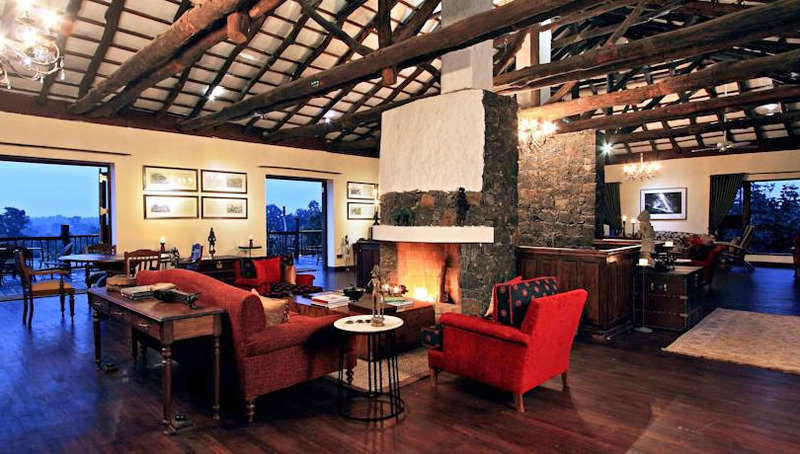 A walk-in, open-plan dressing area had matching his and hers wardrobes with robes and slippers along with lots of shelf space for bags and cases.
A walk-in, open-plan dressing area had matching his and hers wardrobes with robes and slippers along with lots of shelf space for bags and cases.
The bathroom contained a marble washbasin carved out of a single piece, with elephant trunks around it, a dressing table with a useful set of plugs and hairdryer with mirror. There was an oval, free standing bath, antique cabinets full of fluffy white towels, an electric, log-effect fire, candles ready to light and tiger murals.
Off this bathroom, was a second loo and double shower with glass panel allowing you to view your private gravel garden with its six-foot long stone bath, outside shower and bunnies on the walls.
I was glad we were there for three nights, so I could use every bath, shower and loo!
A balcony at the back overlooked trees and had two day beds and arm chairs.
The varied, spacious communal rooms included a large library with pool table, reading area with comfortable sofas and coffee table books, indoor and outdoor dining areas, map room etc.
Days followed a pattern.
5.45am – hot drinks and biscuits over a log fire in the lodge before the morning game drive.
8.30am – a substantial picnic ‘snack’ whilst out – e.g. cheese sandwiches, chocolate chip muffins, cheese straws, nuts, fruit and home-made biscuits along with a full range of Twinings tea, coffee and juices.
11.30am – breakfast back at the lodge included juices, lassi, Indian dishes (potato curry, mushroom pakora, naan bread), a selection of toast, croissants and jams whilst a chef stood by ready to rustle up eggs, sausage and bacon.
1.30pm – three course lunch with soup, and continental dishes like spinach pancakes with Greek salad, or swordfish in lemon butter sauce. My favourite pudding was a shot glass of tart lemon posset with ginger shortbread biscuits.
2.30pm to 6pm – afternoon game drive.
6.05pm – feet washing in beaten silver foot bowls of hot water and floating flowers which greeted us back in our room. Staff would also have run baths for us and served drinks to the room.
Samode pride themselves on surprising you at dinner which is arranged in various locations.
Night 1 – Pre-dinner drinks and canapes were served in the upstairs bar around a log fire. As we were the only guests, we were led along a hurricane-lamp lit path to the spa where, in the entrance, a candle-lit table was beautifully laid with fine glasses, cutlery and napery. A feast followed – an amuse bouche of cucumber and cream cheese, a starter of sweetcorn fritter with cumin mayonnaise, mulligatawny soup. The main course was spicy chicken sausages, rice, potatoes with naan and we finished with masala crème brulee.
Night 2 – started with drinks from a pop-up, but fully stocked bar outside. We sat in comfortable wicker chairs in front of warming braziers to watch a 45-minute DVD about tigers on a large screen. Drinks were constantly refreshed (this was an all-inclusive place) with popcorn and chicken satay being handed round. Dinner was also outside and a buffet of various curries with chicken and prawns cooked on a BBQ followed by chocolate fondants.
Night 3 – we arrived back at camp at 5.15pm, cold and damp after getting caught in a storm. Spirits lifted when we found a lit fire and a table laid with tea, coffee with cake and G&T on offer which we gratefully accepted, along with delicious cheese balls and coriander dipping sauce. Because of the wet weather, dinner was served in the elegant dining room. A shot of spicy soup with mini poppadoms followed by individual thalis with chicken and fish curries, okra, dal, bread, rice and pineapple raita.
10pm – to bed to find almonds on the pillow along with a ‘thought for the day’.
What more could we ask for?
Sarai at Toria
Sarai at Toria, near India’s Panna National Park, had 8 thatched cottages crafted in mud with two-foot thick outer walls and base to provide warmth in the winter and coolness in the summer. The mud floors were finished with a thin layer of cement, coloured with natural mineral oxides: a process which gave a beautiful silky finish and which is practised only by specialist craftsmen from a Southern Indian village.
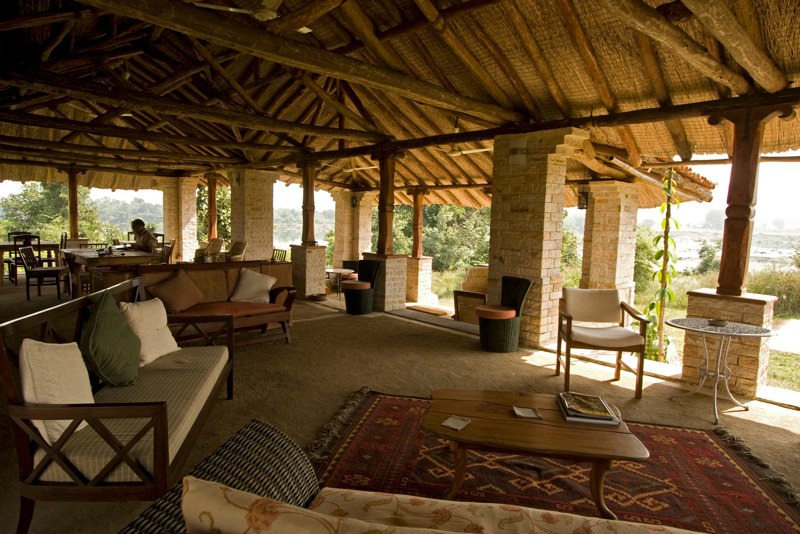 There was a small entrance with tea and coffee making facilities and coat hooks whilst international sockets meant no adaptors.
There was a small entrance with tea and coffee making facilities and coat hooks whilst international sockets meant no adaptors.
Our bed was comfortable with a lightweight white duvet. There were bedside tables and lights and a useful wide, window ledge and chest for storage. Our cottage also had a mezzanine with single bed ideal for a child. The attractive turquoise blue bathroom was practical and huge with an open shower and lots of hot water. The basin, embedded into a wooden dresser with mirror, provided plenty of space for toiletries and hairdryers could be requested.
Hot water was heated by burnable waste products and wood in individual cottage heaters and a free-standing heater, warded off morning chills.
Sarai is eco-friendly with fresh, filtered water available rather than in bottles and instead of being greeted on return from drives with cold flannels, we had glasses of water. Shampoo and soaps, made by Neev, a local women’s development NGO, were natural and free from harmful chemical additives. The solar power was limited to battery back up in the night and a master switch encouraged us not to waste electricity by turning off all lights at once.
A mobile phone in the room had pre-programmed numbers for emergencies.
The main lodge had a large seating area and dining room with rattan blinds which were pulled down at night to enclose it. It was comfortable and simply, but attractively furnished. A large rug and coffee table was moved in the evening and replaced with a ‘fire bucket’ which was moved to the dining area for dinner. WiFi was available and there was a small well stocked library.
A paved area with wicker chairs, caught the morning sun and overlooked the River Ken below and our final breakfast was served here. The lodge had a great vegetable garden where we had lunch of pumpkin soup, followed by an excellent mushroom quiche accompanied by wooden bowl full of glistening, well-dressed, freshly picked salad leaves, tomatoes and cucumber, roasted sweet potato and beetroot. Thankfully the lemon tart was small.
Indian dinners were excellent but not over facing; dal, curries and excellent spicy vegetables from the garden, rice and chapattis. The food was served, but dishes were left on the table so we could help ourselves to more.
As well as morning and afternoon game drives, we enjoyed the 3km walk to Toria the village: a pleasant, flat walk along a sandy track where we met buffalo and workers returning from the fields with their harvest either on bikes or their heads. We also visited one of the homesteads to see how simply the villagers lived.
As India’s National Parks are closed on Wednesday afternoons, we took advantage of the lodge’s location and walked down to the river bed, across a narrow rickety bamboo bridge to a small canoe. Sitting on patterned cushions, with the oarsman at the front with his one paddle, we glided silently and gently. We saw lots of birds at close quarters (jet black cormorants, blue kingfisher, heron, lapwing, crested eagle etc.) and fishermen precariously balanced on wooden plank across tyre inner tubes.
The lodge is owned by Dr Raghu Chundawat and his wife, Joanna Van Gruisen. Before dinner, over G&Ts and excellent popcorn poppadoms, we watched a DVD, Tigers in the Emerald Forest, a 2003 BBC production about Raghu and his fight to save the tigers in Panna which were becoming extinct due to poaching. Unfortunately, he created too many political waves for the state government and his funding was stopped. Eventually tigers were wiped out but have now been reintroduced from other state parks. They have continued to breed and now number around 40 with eleven being collared to help with tracking so spotting chances are good.
Credit cards are not taken.











